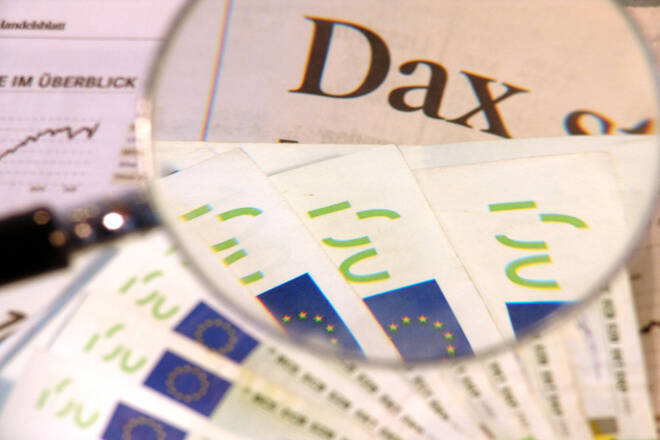Advertisement
Advertisement
DAX Anticipation Over, Fed Chair Powell Testimony to Move the Dials
By:
It is a quiet day ahead on the European economic calendar. There are no stats to consider, leaving the DAX firmly in the hands of Powell testimony.
It was a bearish Tuesday session for the DAX, falling 0.55%. Following a 0.96% loss on Monday, the DAX ended the day at 16,111. Significantly, the DAX saw red for the third time in seven sessions.
The PBoC set the tone ahead of the European opening bell. In line with expectations, the PBoC cut the 5-year LPR from 4.3% to 4.2% and the 1-year LPR from 3.65% to 3.55%.
Investors hoped for larger-than-forecast cuts to Loan Prime Rates. The disappointment weighed on riskier assets, with Beijing holding back from rolling out a stimulus package for the ailing Chinese economy, adding to the bearish mood.
Economic indicators from Germany were also bearish as investors looked ahead to two days of Fed Chair Powell testimony on Wednesday and Thursday.
US housing sector data failed to distract investors despite better-than-expected housing start and building permit numbers.
German Economic Indicators Flash Red
It was a quiet European session. However, economic indicators from Germany gave investors more reason to fret over the economic outlook and the global macroeconomic environment.
The German Producer Price Index declined by 1.4% in May versus a 0.3% increase in April. Economists forecast a 0.7% decline. Year-over-year, the Producer Price Index increased by 1.0%.
After the hawkish ECB press conference, the latest figures reflected persistent food price pressures while suggesting weaker demand, with the marked monthly fall in the Index.
The Market Movers
It was a bearish Tuesday session for the auto sector. Continental AG slid by 3.24%, with Volkswagen and Porsche seeing losses of 1.47% and 1.98%, respectively. BMW and Mercedes-Benz Group also struggled, falling by 0.45% and 0.65%, respectively.
It was also a bearish session for the banks. Commerzbank and Deutsche Bank ended the day down 0.39% and 0.84%, respectively.
The Day Ahead for the DAX
There are no economic indicators from the euro area to draw interest today. The lack of economic indicators will leave central banks in the spotlight.
A non-committal ECB Chief Economist Philip Lane vis-a-vis a September move leaves ECB Executive Board members to move the dial. On Monday, Lane acknowledged the ECB would likely raise rates in July while saying it was too early to talk about a September move that will be data-dependent.
While ECB Executive Board members have lined up behind ECB President Lagarde to deliver a likely hike in July, the jury is out on what to expect in September, with cracks in the euro area economy likely to test the doves.
With no economic indicators to consider, investors should track ECB commentary throughout the day. ECB Executive Board member Isabel Schnabel is on the calendar to speak today. Hawkish September policy chatter would influence.
Looking ahead to the US session, it is another quiet day on the US economic calendar. There are no US economic indicators to influence. The lack of economic indicators will leave Fed Chair Powell and FOMC member commentary to move the dial.
Fed Chair Powell will give the first day of testimony. While the FOMC press conference was only last week, investors should look for any deviation from the FOMC press conference script.
The anticipation of Fed Chair Powell’s testimony on interest rate expectations was telling. According to the CME FedWatch Tool, the probability of a 25-basis point July rate hike stood at 76.9% on Tuesday, up from 74.4% on Friday. The chances of the Fed lifting the Fed Funds Rate to 5.75% in September increased from 8.9% to 12.3%.
DAX Technical Indicators
Looking at the EMAs and the 4-hourly chart, the EMAs sent bullish signals. The DAX sat above the 50-day EMA (16,104). The 50-day EMA pulled further away from the 100-day EMA, with the 100-day EMA widening from the 200-day EMA, delivering bullish signals.
A hold above the 50-day EMA (16,104) would support a breakout from R1 (16,174) to give the bulls a run at R2 (16,236) and 16,250. However, a fall through the 50-day EMA (16,104) would signal a fall through S1 ($16,059) to bring S2 (16,006) into view. A fall through the 50-day EMA (16,104) would send a bearish signal.
Resistance & Support Levels
| 16,174 | S1 | 16,059 |
| 16,236 | S2 | 16,006 |
| 16,351 | S3 | 15,891 |
The DAX has to move through the 16,121 pivot to target the First Major Resistance Level (R1) at 16,174 and the Tuesday high of 16,184. A return to 16,150 would send a bullish signal. However, the DAX would need Fed Chair Powell to support a breakout.
In the case of an extended rally, the bulls will likely test the Second Major Resistance Level (R2) at 16,236 and resistance at 16,250. The Third Major Resistance Level (R3) sits at 16,351.
Failure to move through the pivot would leave the First Major Support Level (S1) at 16,059 in play. However, barring a Fed-fueled sell-off, the DAX should avoid sub-16,000. The Second Major Support Level (S2) at 16,006 should limit the downside. The Third Major Support Level (S3) sits at 15,891.
The DAX Futures Sees Green
Across the futures markets, DAX was up 31 points, while the Dow and NASDAQ were down by 9 and 6.5 points, respectively.
For a look at the economic events, check out our economic calendar.
About the Author
Bob Masonauthor
With over 28 years of experience in the financial industry, Bob has worked with various global rating agencies and multinational banks. Currently he is covering currencies, commodities, alternative asset classes and global equities, focusing mostly on European and Asian markets.
Advertisement
